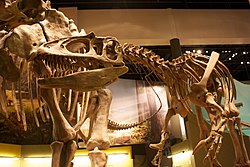| Saurophaganax | |
|---|---|

| |
| Reconstructed skeleton at the Sam Noble Oklahoma Museum of Natural History | |
| Scientific classification | |
| Domain: | Eukaryota |
| Kingdom: | Animalia |
| Phylum: | Chordata |
| Clade: | Dinosauria |
| Clade: | Saurischia |
| Clade: | Theropoda |
| Clade: | †Carnosauria |
| Superfamily: | †Allosauroidea |
| Genus: | †Saurophaganax Chure, 1995 |
| Species: | †S. maximus
|
| Binomial name | |
| †Saurophaganax maximus Chure, 1995
| |
| Synonyms | |
| |
Saurophaganax ("lord of lizard-eaters") is a genus of large allosauroid dinosaur from the Morrison Formation of Late Jurassic (latest Kimmeridgian age, about 151 million years ago) Oklahoma, United States.[1] Some paleontologists consider it to be a junior synonym and species of Allosaurus (as A. maximus). Saurophaganax represents a very large Morrison allosauroid characterized by horizontal laminae at the bases of the dorsal neural spines above the transverse processes, and "meat-chopper" chevrons.[2] It was the largest terrestrial carnivore of North America during the Late Jurassic, reaching 10.5 metres (34 ft) in length and 2.7–3.8 metric tons (3.0–4.2 short tons) in body mass.
- ^ Turner, C.E. and Peterson, F., (1999). "Biostratigraphy of dinosaurs in the Upper Jurassic Morrison Formation of the Western Interior, U.S.A." Pp. 77–114 in Gillette, D.D. (ed.), Vertebrate Paleontology in Utah. Utah Geological Survey Miscellaneous Publication 99-1.
- ^ Glut, Donald F. (1997). "Saurophagus". Dinosaurs: The Encyclopedia. Jefferson, North Carolina: McFarland & Co. pp. 793–794. ISBN 978-0-89950-917-4.